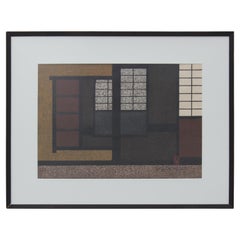Tadashige Ono
20th Century Modern Landscape Prints
Woodcut
20th Century Modern Prints and Multiples
Woodcut
Recent Sales
20th Century Modern Interior Prints
Woodcut
1960s Modern Figurative Paintings
Woodcut
Vintage 1960s Japanese Mid-Century Modern Prints
Metal
Vintage 1950s Paintings
Paper
Mid-20th Century Modern Prints and Multiples
Woodcut
20th Century Modern Interior Prints
Woodcut
20th Century Modern Interior Prints
Woodcut
1960s Modern Figurative Prints
Woodcut
1950s Abstract Impressionist Abstract Prints
Paper, Woodcut
1950s Cubist Still-life Prints
Paper, Woodcut
People Also Browsed
Vintage 1960s Japanese Showa Prints
Paper
Antique 15th Century and Earlier Japanese Japonisme Scholar's Objects
Stone
Antique 19th Century Japanese Meiji Ceramics
Porcelain
2010s South African Minimalist Pedestals
Hardwood
Vintage 1960s Japanese Showa Prints
Glass, Wood, Paper
Early 20th Century Japanese Taisho Paintings and Screens
Paper
Vintage 1960s Japanese Showa Prints
Paper
1990s Japanese Mid-Century Modern Prints
Paper
20th Century Japanese Taisho Paintings and Screens
Brass
21st Century and Contemporary Abstract Expressionist Abstract Paintings
Oil
Vintage 1960s Japanese Showa Prints
Paper
Vintage 1930s Japanese Showa Paintings and Screens
Silk
Vintage 1960s Japanese Showa Prints
Glass, Wood, Paper
Late 20th Century Japanese Japonisme Paintings and Screens
Paint, Paper
Vintage 1960s Japanese Showa Prints
Glass, Wood, Paper
1960s Abstract Geometric Abstract Prints
Woodcut
Kiyoshi Saitō for sale on 1stDibs
Kiyoshi Saito was born in Fukushima Prefecture in 1907. At the age of five, he moved to Otaru in Hokkaido, where he would come to serve as an apprentice to a sign painter. Saito became infatuated with art after studying drawing with Gyokusen Narita and moved to Tokyo in 1932 to study Western-style painting at the Hongo Painting Institute. He began experimenting with woodblock prints and exhibiting his works with Nihon Hanga Kyōkai in 1936. Saito mainly worked in oil painting until his invitation from Tadashige Ono to join the Zokei Hanga Kyokai in 1938, at which time Saito made the woodblock print his primary medium. He worked with the Asahi Newspaper Company in 1943, where he met Kōshirō Onchi. This chance encounter led to an invitation to Ichimoku Kai and membership to Nihon Hanga Kyōkai in 1944.
Saito’s printmaking career was put on hold due to the war. During the occupation, he sold his first print in an exhibit with fellow artists Un’ichi Hiratsuka and Hide Kawanishi. In 1948, Saito exhibited at the Salon Printemps, an event sponsored by Americans for Japanese Artists. At the Sao Paulo Biennale of 1951, Saito won first place for his print Steady Gaze. In competition with Japanese oil painting and sculpture, this was a turning point for Japanese printmakers: For the first time in Japanese history, prints overtook painting. This achievement roused the Japanese art establishment. In 1956, Saito was sponsored by the state department and the Asia Foundation to travel and exhibit around the United States and Europe. As a sōsaku-hangaartist, Saito’s prints are self-drawn, self-carved and self-printed. His early works are distinguished by an attention to realism and three-dimensionality. As his style evolved, his prints became flattened and two-dimensional, featuring strong and refined designs with color and texture. Kiyoshi Saito passed away in 1997.
Finding the Right Prints-works-on-paper for You
Decorating with fine art prints — whether they’re figurative prints, abstract prints or another variety — has always been a practical way of bringing a space to life as well as bringing works by an artist you love into your home.
Pursued in the 1960s and ’70s, largely by Pop artists drawn to its associations with mass production, advertising, packaging and seriality, as well as those challenging the primacy of the Abstract Expressionist brushstroke, printmaking was embraced in the 1980s by painters and conceptual artists ranging from David Salle and Elizabeth Murray to Adrian Piper and Sherrie Levine.
Printmaking is the transfer of an image from one surface to another. An artist takes a material like stone, metal, wood or wax, carves, incises, draws or otherwise marks it with an image, inks or paints it and then transfers the image to a piece of paper or other material.
Fine art prints are frequently confused with their more commercial counterparts. After all, our closest connection to the printed image is through mass-produced newspapers, magazines and books, and many people don’t realize that even though prints are editions, they start with an original image created by an artist with the intent of reproducing it in a small batch. Fine art prints are created in strictly limited editions — 20 or 30 or maybe 50 — and are always based on an image created specifically to be made into an edition.
Many people think of revered Dutch artist Rembrandt as a painter but may not know that he was a printmaker as well. His prints have been preserved in time along with the work of other celebrated printmakers such as Pablo Picasso, Salvador Dalí and Andy Warhol. These fine art prints are still highly sought after by collectors.
“It’s another tool in the artist’s toolbox, just like painting or sculpture or anything else that an artist uses in the service of mark making or expressing him- or herself,” says International Fine Print Dealers Association (IFPDA) vice president Betsy Senior, of New York’s Betsy Senior Fine Art, Inc.
Because artist’s editions tend to be more affordable and available than his or her unique works, they’re more accessible and can be a great opportunity to bring a variety of colors, textures and shapes into a space.
For tight corners, select small fine art prints as opposed to the oversized bold piece you’ll hang as a focal point in the dining area. But be careful not to choose something that is too big for your space. And feel free to lean into it if need be — not every work needs picture-hanging hooks. Leaning a larger fine art print against the wall behind a bookcase can add a stylish installation-type dynamic to your living room. (Read more about how to arrange wall art here.)
Find fine art prints for sale on 1stDibs today.
